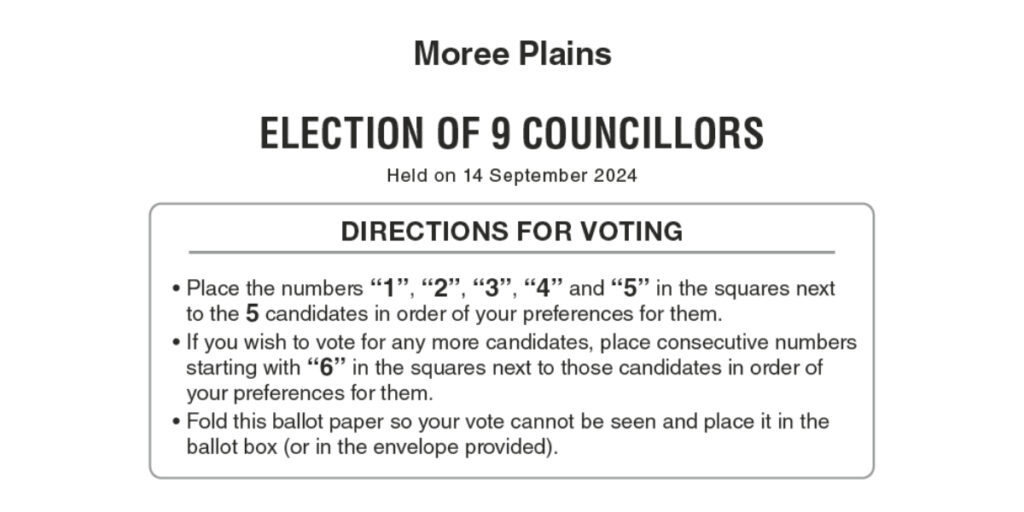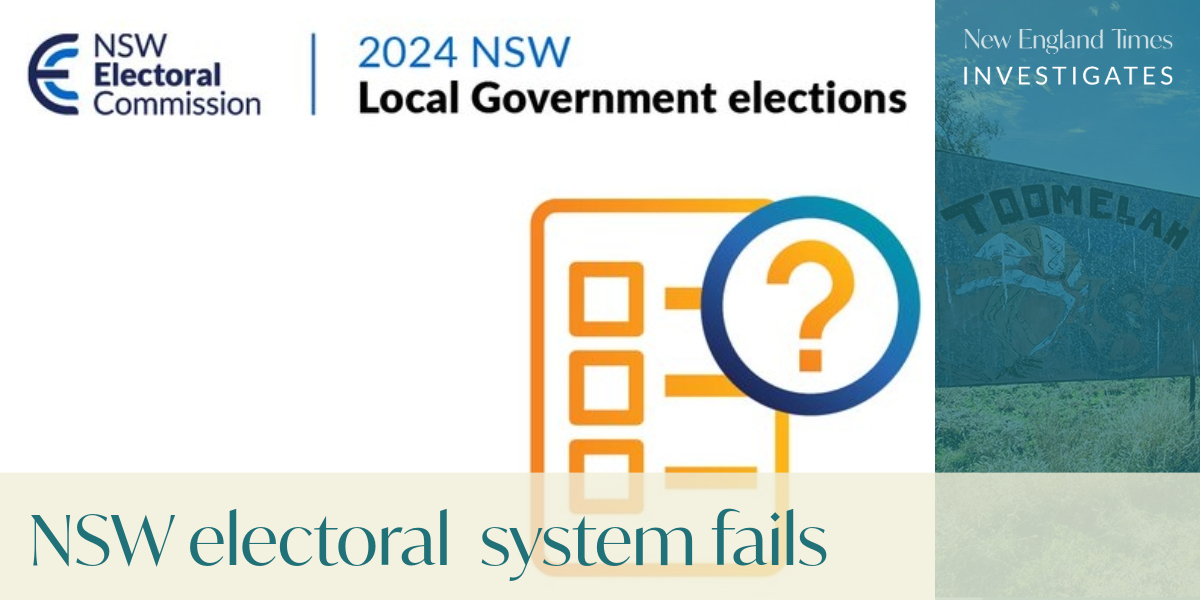Something went very wrong in the local government election in September.
A 93% informal rate in Toomelah sparked our investigation, which found hundreds of voters in Moree Plains Shire did not have their votes counted, potentially robbing a young Gomeroi woman, Mekayla Cochrane, her seat on Council.
The NSW Electoral Commission says they have done nothing wrong, they don’t set the policy, ask the Minister for Local Government. Minister for Local Government says he has no role in running elections, ask the NSW Electoral Commission.
As the NSW Electoral Commission scrambles to defend its actions, the responsible minister has expressed ‘concern’ and kicked the problem to the tall grass of a parliamentary inquiry.

As we continued in our quest to find what went wrong in the local government election, we prepared a six page document with 22 questions, sent to the NSW Electoral Commission on the 21st of October. The document included ten examples from the Moree Plains Shire council election of different types of votes deemed informal by the NSW Electoral Commission’s computer, despite it being very clear what the voter’s intention was, and savings provisions that should have applied, and asked for an explanation of each.
On the 31st of October, a one-and-a-half page response was received, unsurprisingly not answering many of the questions put. Most of the response was restating very basic information available from the website, and already stated in previous unsatisfactory answers. The only difference is that, in addition to maintaining the absurd position that there is nothing went wrong in the local government elections, the assertions have reached the level of farce.
Please read the instructions carefully
At the core of this issue are matters of poor communication. Poorly written legislation and regulations, poor interpretation of those regulations, poorly formed ballot papers lacking clear instruction, and poorly communicated voting requirements.
“The ballot paper provides instructions for what is required to submit a formal vote,” the NSW Electoral Commission said.
No, it does not.
There is no wording on the ballot paper that would support the Electoral Commission’s contention that there was any minimum number of candidates to vote for. It gives an instruction to put numbers in squares next to candidates. It instructs you to fold you ballot paper and place it in the ballot box. The word minimum, or any synonym for minimum, is simply not on the paper.

Specifically on the Moree Plains Shire ballot paper, the instructions read: Place the numbers “1”, “2”, “3”, “4”, and “5” in the squares next to the 5 candidates in order of your preference for them. It does not say anywhere that you have to vote for a minimum of 5 candidates or your vote will not be counted.
As noted in our earlier story, the entire basis for not counting votes with less than 5 candidates voted for is solely on the form of the ballot paper – there is no minimum preferences requirement in the legislation or regulation.
“Staff are trained to inform electors to read and follow the instructions on the ballot paper,” the NSW Electoral Commission said.
Except that according to reports, no verbal instructions were given in Toomelah. And even if they were given, the instructions on the ballot paper do not include any instruction in regard to a minimum number of preferences. The NSW Electoral Commission declined to provide a copy of training materials.
“The NSW Electoral Commission implemented a state-wide voter awareness advertising campaign from July to election day, Saturday 14 September. This included messaging about where to find information about how to complete ballot papers. We also advertised in seven community languages and across channels with high Aboriginal audiences. Local councils were strongly encouraged to advertise in their local communities and a series of education videos and resources were provided to councils to share through their campaigns and networks,” they said.
Setting aside that there was little to no advertising in the New England (certainly, none on this site and none that any of our team saw), the materials produced all said the ballot paper would tell you the minimum number of candidates you needed to vote for. Which it does not.
Saving face rather than votes
It is on their interpretation of savings provisions in section 345 of the regulations that the NSW Electoral Commission makes the leap from disingenuous to gaslighting.
“Section 345(2)(e) applies to a ballot paper with the preference ‘1’ and crosses. It does not apply to a ballot paper with the preference ‘1’, other preferences, and crosses,” they said.
Section 345(2)(e) makes no such stipulation. It says “the elector has recorded a vote by placing the number “1” or a tick in a square and placing a cross in (or a line through) all or some of the other squares on the ballot-paper, but the ballot-paper is to be treated as if the marks in those other squares did not appear on the ballot-paper and any tick were the number “1””. This savings provision is a fairly clear instruction to ignore the other marks and count the 1. Even if it is a tick, count it as a 1, and count the vote.
“Section 345(2)(e) provides that crosses are to be treated as if they do not appear on a relevant ballot paper. For this reason, a relevant ballot paper will be treated as if only a first preference ‘1’ appears on the ballot paper. Accordingly, there would be insufficient preferences for such a ballot paper for Moree Plains Shire Council (MPSC) to be formal,” they said.
Not only is the obviously untrue because there is no minimum number of preferences required by the form of the Moree Plains Shire ballot paper, there are multiple other votes within the data file where less than 5 preferences were counted as a result of a savings provision being applied.
In fact, had the staff of the NSW Electoral Commission done so much as actually open the vote data file of the Moree Plains Shire Council election to answer our questions, they would have seen that in the very first vote at the top of the file – ballot paper ID 1.

“Section 345(2)(b)(ii) does not save a break in the order of preferences that is greater than one preference,” they said.
Again, Section 345(2)(b)(ii) makes no such stipulation. Quite the opposite. It reads “there being a break in the order of preferences recorded on the ballot-paper, but the ballot-paper is to be treated as if any subsequent preference had not been recorded on the ballot-paper”. Thus, if the vote were handled properly, it is not possible to have a second break in the sequence, because any numbers after the first break are, effectively, not there.
Who is running the show?
The staff of Minister for Local Government, Ron Hoenig, have repeatedly asserted that they have no role in the conduct of local government elections.
“Neither the Minister nor the Office of Local Government has any role in the administration of local council elections. Any questions about the administration of Moree Plains Shire Council’s election should be directed to the NSW Electoral Commission,” their spokesperson repeatedly said.
Indeed the Minister’s staff went so far as to arrange a call from the Office of Local Government, so that a public servant could explain to New England Times in some detail that they have no role, the NSW Electoral Commission tells them what to put in the regulations, and they just do that.
The NSW Electoral Commission confirmed that they do provide advice on electoral matters, but then went on to directly contradict the Minister for Local Government’s assertion that the NSW Electoral Commission was the one calling the shots on elections:
“However, it is not the role of NSW Electoral Commission to determine the policy settings underpinning legislation; the NSW Electoral Commission administers the legislation as it is made by the NSW Parliament. Concerns or suggestions with respect to changes to the system of voting or formality rules that apply to local government elections should be raised with the Minister for Local Government.”
These issues were raised with the Minister for Local Government. Multiple times.
Repeated attempts to push back to either the Minister for Local Government or the Electoral Commission has only resulted in them continuing to point at the other.
Meanwhile Special Minister of State John Graham, who has oversight of the NSW Electoral Commission, was not answering questions at all.
Until we kicked our increasingly pointed questions up to his boss, NSW Premier Chris Minns. We then received the following response from Graham:
“It is extremely concerning to see such a spike in the rate of informal votes in Toomelah. We want every vote in every community to count at every election.”
“Earlier this year, I asked the NSW Parliament’s Joint Standing Committee on Electoral Matters to hold an inquiry into proposals to increase voter engagement, participation and confidence. The issue raised in the Moree Plains falls squarely into its Terms of Reference.”
“Committee Chair Peter Primrose MLC has been informed of this issue and has committed to ensuring it will be looked at by the inquiry.”
(Ironically, Peter Primrose’s other title is “Labor spokesperson for the Northern Tablelands”.)
The press release from May of this year heralding this inquiry stated:
The bipartisan Joint Standing Committee on Electoral Matters has been asked to report on electoral laws and practices that would support the following targets:
- 100% enrolment
- 100% turnout
- 100% formal voting
- 100% voter confidence
Setting aside the fact that 100% any of those things is impossible, it would be fair to say that a good start might be counting their votes.
In the next part of our investigation, we go beyond the Moree Plains to find that thousands of votes across the New England, and indeed the rest of the state, were not counted. And it’s happened before.
Read the other parts of this investigation
Like what you’re reading? Support The New England Times by making a small contribution today and help us keep delivering local news paywall-free. Support now


